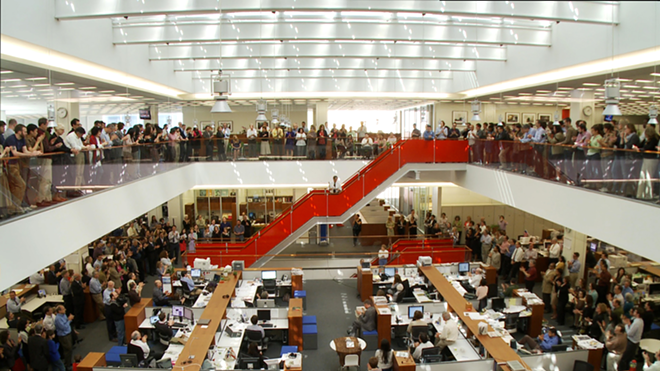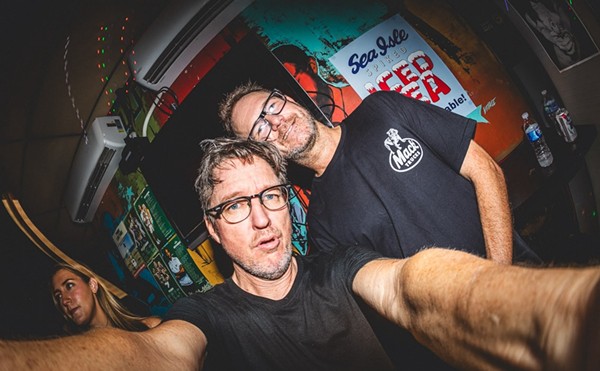The new documentary Page One: Inside the New York Times opens inside a Times production facility. We watch as giant spools of newsprint are driven around on forklifts before being fed into a massive printing press. Despite the clean, modern look of the footage, the whole scene seems dated — like watching an industrial film from the 1950s. In an age where any schmuck with a laptop and an Internet connection can have his opinions read by millions, is it any wonder that old-media newspapers are dying?
Page One provides a travelogue through the newspaper business, which went from gilded age to twisted wreckage in what seemed like the blink of an eye. Starting in 2008, reporting on media companies began to focus almost exclusively on layoffs, bankruptcies and going-out-of-business fire sales — a trend that continues to this day. That year also marked the Times' creation of a media desk, staffed by columnist David Carr, reporter Brian Stelter and editor Bruce Headlam. They've been busy ever since.
The film works as a tour of major media trend stories from the last three years. Covered in some way are the birth of Wikileaks; how media cutbacks/layoffs are affecting coverage; the merger of cable giant Comcast and NBC; the emergence of new media like Twitter and new technology like the iPad, and their disruptive effect on old media like the Times; and the epic and tawdry bankruptcy of the Tribune Company, which features some great quotes from CEO Sam Zell, including "Why don't we have a porno section?" and "I want to [cover] puppies and Iraq." Is it any wonder Tribune Co. exploded like a firework?
Carr emerges as the most interesting personality in the film. A former crack addict who served as a single parent to two children (sometimes on welfare), Carr not only survived his addiction and a trip to jail for cocaine possession, but he has found a way to thrive at the notoriously competitive Times. He's a true believer in the paper (somewhat ironically, since he made his reputation early on at alternative newsweeklies, including the Washington City Paper, now part of the Creative Loafing chain), and Page One repeatedly shows Carr defending the Times. "Just because you put on a fucking safari helmet … it doesn't give you the right to insult what we do," he tells Shane Smith, creator of Vice Guide to Travel after Smith wrongly slammed the Times coverage of Liberia as limited to surfing. We see him in panel discussions (Daily Kos founder Markos Moulitsas spanks Carr over the Judith Miller/WMD debacle) and even on what looks like a TV debate show (where Carr crushes newser.com's Michael Wolff). Stalking the office like a slimmed-down Quasimodo, speaking with the rasp of a man who just swallowed a lit cigarette, Carr is the still-beating heart of journalism — roughed up, ragged but still here.
My only real complaint about Page One is that it doesn't do a very good job of actually going inside the New York Times. Besides profiling the media desk and lightly touching on foreign coverage, Page One doesn't reveal much about the old gray lady that you didn't already know. How can a movie claim to be the inside story of the Times and only feature a few short quotes from Editor Bill Keller and one sentence from publisher Arthur Sulzberger, Jr., lifted from a Charlie Rose appearance, no less? It can't.
So maybe they should have called it something different, because director Andrew Rossi has assembled a compelling and watchable film that asks big questions about the future of the media. If companies like the Times go under, all the aggregators, like Gawker and Huff Post, are going to see gaping holes in their pages as well, since so much of what those guys do is either lifted from or bouncing off of the Times. And what of new media reporters? The Times' Brian Stelter was a 21-year-old blogging phenom whom the Times plucked from obscurity, whose work method consists of actively clacking away on two computers, watching a TV, talking on the phone and tweeting — all at the same time. As Carr says, "I still can't get over the feeling that Brian Stelter is a robot assembled in the basement of the New York Times to come and destroy me."
But maybe that's what it always feels like when the future intrudes on the present. And the future is always intruding, especially in the news business. What does that future hold for the Times? Who knows? But I was struck by something Bill Keller says: "Wikileaks doesn't need us. [Pentagon Papers leaker] Daniel Ellsberg did." The question remains whether readers need the Times. Page One argues yes, but this story is to be continued …

















